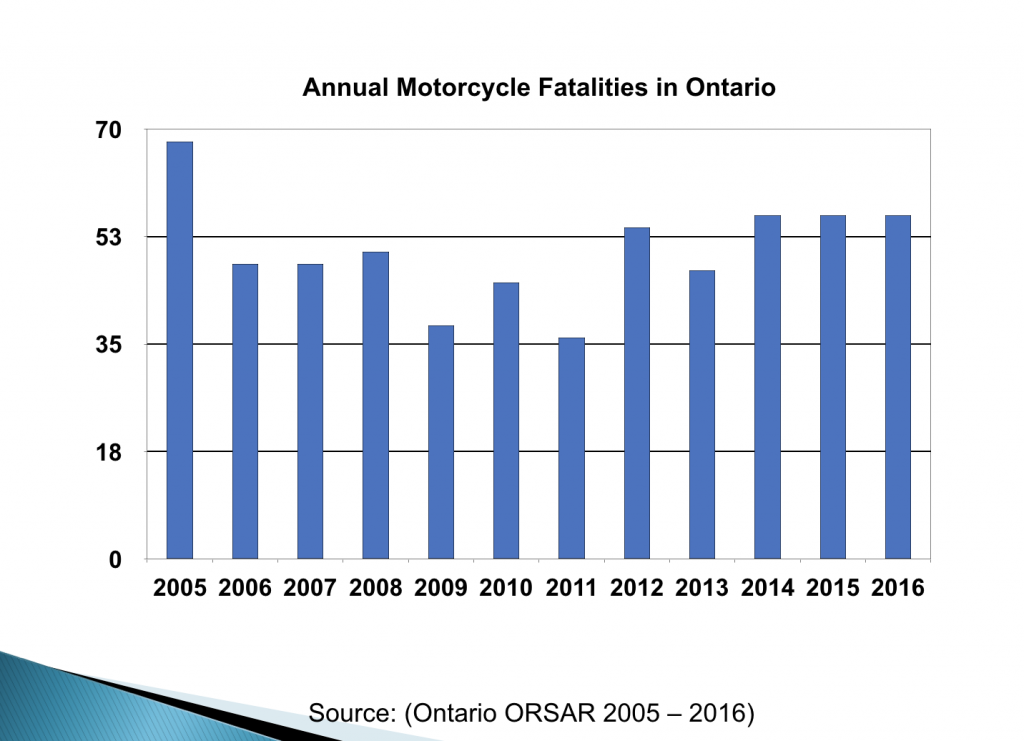
Chad Harvey having his motorcycle blessed along with fellow riders by Father Shea, pastor at St. Joseph’s Church, Belleville. Motorcycle riders of all denominations asked God for protection for themself and those they share the rode with. Photo by Gail Paquette.
By Jessica Clement [1]
BELLEVILLE – A recent study pushed the message that riding a motorcycle hasn’t become any safer in Ontario over the years, but a Canadian safety expert disagrees.
General manager of the Canada Safety Council, Raynald Marchand, said that the statistics don’t account for the increased number of motorcycles registered. Transport Canada shows registrations have been on a steady rise between 2005 and 2015.
The researchers behind the study [2] published in the Canadian Medical Association Journal claim that although it is widely understood that there is a higher risk of death or injury associated with riding motorcycles, the knowledge has done little to lower the number of crashes in recent years. In August Sgt. Kenny Schmibt stated in a video [3] posted to Twitter that the Ontario Provincial Police had responded to 30 deadly motorcycle crashes so far in 2017. At the time this was only six less than 2016 – what the OPP claimed was as worst year for motorcycle fatalities in the last decade. The number of deaths has since risen. Added to the list of fatalities was 68-year-old Douglas Ray of Stirling-Rawdon Township in October. Ray was struck by an driver attempting to make a lefthand turn – one of the most common causes of collisions.
Motorcyclists in Ontario are five times more likely to die as a result of a collision, the study suggests while urging for public health strategies aimed at improving motorcycle safety.
“Motorcycle fatalities are way down from what they were years ago in Canada,” Marchand said.
While motorcycles make up only five per cent of motorized activity on roads, they are linked to approximately 10 per cent of all collisions in Ontario, the study claimed.
According to Marchand there is little change in motorcycle fatalities in Ontario over the last three years.
“In Ontario we are doing way better than ten years ago,” Marchand said, referring to statistics from Ontario Road Safety Annual Reports. Motorcycle fatalities in Canada in 2015 were significantly lower than the rates in 2005.
In the province it is legal for anyone 16 or older who has passed a vision test along with a traffic safety written test to ride a motorcycle of any size on roads with maximum speeds of up to 80 KM/h in the daytime. Fatal crashes are more common in rural areas, of which 59 per cent of riders are under the age of 45. 72 per cent of fatalities in urban areas are riders under the age of 45.
However, the study stated that insurance companies that raise rates have already acted as a deterrent to motorcycle use, doing so in response to private medical costs.
“The study is using recent successes from car safety and innovation to shame motorcyclists. This is just wrong,” Marchand said. Continuable advancements in safety technology in automobiles could affect statistics in such a way that at first glance it would seem motorcyclists are in increasing danger.
Though several studies suggest that drivers of automobiles are disproportionately responsible for motorcycle accidents, the Loyalist Training and Knowledge Centre offers four levels of motorcycle skills training approved by the Canada Safety Council in efforts to increase knowledge and safety for riders in the Quinte area. As part of this program an eight-hour refresher course is also offered for M2 and M licensed riders.